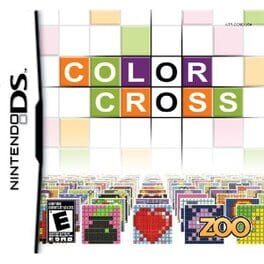

Color Cross is a challenging puzzle game where the goal is to uncover the hidden picture by applying the right color to the appropriate square. Utilizing the familiar "paint by numbers" picture logic puzzle mechanic, completing a grid will reveal a portion of a larger hidden image as well as unlocking increasingly difficult challenges. With over 150 individual grids to unlock, Color Cross provides hours of brain-teasing gameplay that is colorful in more ways than one.
Reviews View More
Completion: Beat every puzzle in the game with zero mistakes.
Review: This was one of the random games I had as a kid for the DS. As someone who enjoys picross nowadays, I thought this would be a fun play as it has the unique multi-color twist. Unfortunately, this game was just not made very well. A lot of the colors they chose blend in with each other, and it makes it hard to see and easy to make mistakes. The game is also very boring, and the art is not good. To put in simply, this was a good idea ruined by poor execution.
Proof of Completion
Review: This was one of the random games I had as a kid for the DS. As someone who enjoys picross nowadays, I thought this would be a fun play as it has the unique multi-color twist. Unfortunately, this game was just not made very well. A lot of the colors they chose blend in with each other, and it makes it hard to see and easy to make mistakes. The game is also very boring, and the art is not good. To put in simply, this was a good idea ruined by poor execution.
Proof of Completion
The idea of picross but with multiple layers that you need to work through is a pretty good one, but unfortunately it's let down here by the puzzle difficulty being pretty slow to ramp up, and the interface being not very good. It's very easy to make accidental inputs, which the game always punishes you for - there's no Free Mode here ala Picross DS. Additionally, as puzzles become larger they come more unwieldy on phone screens. A good idea, but badly executed.
Legitimately disappointing as a Picross knockoff because the color mechanic occasionally works really well. I think it helps illustrate why the proper Picross series didn't mess with color until the second entry in the 3D series and why, when they did, they made it two colors. When I would come across puzzles in this game that used two shades of yellow/green that looked quite a bit like the parts of the grid I hadn't solved yet it was just immediately a terrible time. Which is a shame, because in its best moments it does communicate that feeling of brush strokes that the premise should naturally capitalize on.
Also, at this point I'm not really a fan of 2D nonogram puzzles where a misclick is an automatic penalty, especially when puzzle size gets wild. I'm a much bigger fan of just relying on my own awareness to know something was a misclick and fixing it myself, and for puzzle solve "fails" to be getting to a point where I clearly messed up somewhere and the puzzle is unsolvable. Starting a puzzle over because the game registered my stylus taps slightly differently than I wanted is not a great feeling.
Also, at this point I'm not really a fan of 2D nonogram puzzles where a misclick is an automatic penalty, especially when puzzle size gets wild. I'm a much bigger fan of just relying on my own awareness to know something was a misclick and fixing it myself, and for puzzle solve "fails" to be getting to a point where I clearly messed up somewhere and the puzzle is unsolvable. Starting a puzzle over because the game registered my stylus taps slightly differently than I wanted is not a great feeling.
